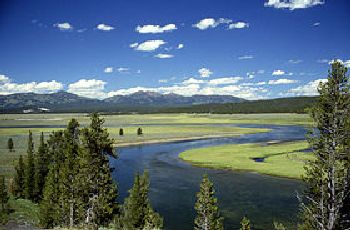by Larry
February, 2012Landslide!In my travels, though, I am often awed by how insignificant we are compared with more natural phenomena. In Yellowstone, there was evidence of an immense caldera that periodically has devastated much of the area we now regard as our "lower 48." Among the redwoods in OR and CA I took note that I am in fact rather puny next to a 2000 year old, 300 foot high evergreen. In AR, gazing down at nearly 2 billion years of geological record, I marveled at the vastness of the Grand Canyon. In CO, it was the Rockies, there long before our species' entry onto the stage, likely also to still be around long after our kind is no more. We are told that the origin of all that is, including time and space, occurred some 14-15 billion light years ago and began with everything compressed into an unimaginably small something, called a singularity. If temperature had any meaning, it is said to have been billions of degrees hotter than could ever support carbon-based life. It is kind of hard sustaining the idea of my significance relative to that.
Still, the fact is that even much, much smaller natural occurrences can seem pretty darned exciting to the likes of this 5' 6" and 150 pound Larry. For instance, I was terribly impressed on May 18, 1980, just before Mount St. Helens blew its top, when an earthquake unleashed there a most massive shifting of earth, snow, and rock, perhaps the then largest in recorded history. How big was the landslide? It covered an area of around 24 square miles under roughly 600 feet of debris, a total deposit of 0.7 cubic miles. Worse was to come. The extremely rapid, deep slide exposed underlying magma, triggering a pyroclastic flow which passed over the still racing landslide, accelerating to about 670 MPH and decimating Spirit Lake, North Fork Toutle River, and hundreds of square miles of former forest land. When Spirit Lake was vaporized, the explosion was heard in British Columbia, ID, MT, and northern CA. Even Mount St. Helens' dramatic landslide now is reckoned slight, though, following the discovery in 2007 of a landslide that had occurred 60,000 years ago. This undersea one happened off the coast of northwest Africa. The cataclysm there involved an amount of sediment equal to the cumulative total of all the world's river deposits for a decade. An underwater landslide was the catalyst for a surge of sediment-laden water that traveled over a seafloor area up to 93 miles wide and 932 miles long (roughly the distance from Austin to Denver). 225 billion metric tons of sediment, more than unleashed by many volcanoes erupting at once, were displaced. This discovery was made by researchers using core samples drilled into the sea bed from the research vessel "Charles Darwin," as reported in the journal "Nature" (Phillip A Allen in "Earth Science: Sediment en route to oblivion," pages 490-491; 22 Nov., 2007) and by Paul Rincon in an article titled "Undersea Slide Set Off Giant Flow," BBC News; 22 November, 2007. When I was little, I liked to play in the dirt and mud with tiny dump trucks. I got a keen sense of power from hauling these toy truckloads of sandy debris from one place to another. Nevertheless, the discovery off northwest Africa puts my efforts in perspective. Maybe if I had kept at it for a couple trillion years I might have shifted that much earth. |
